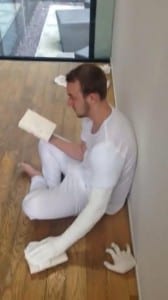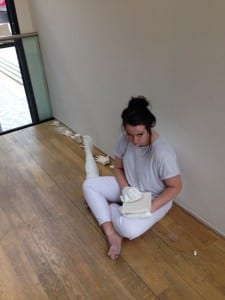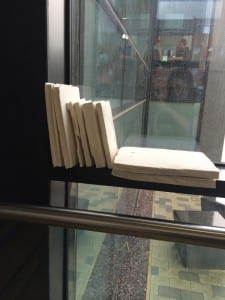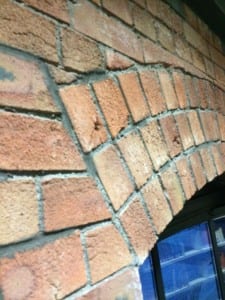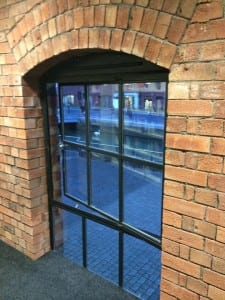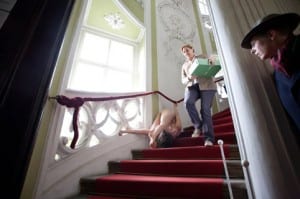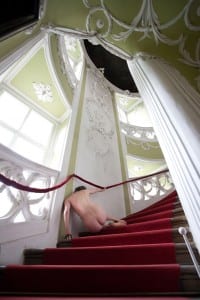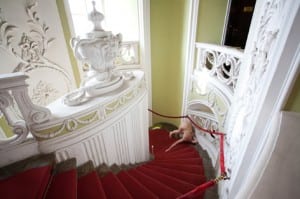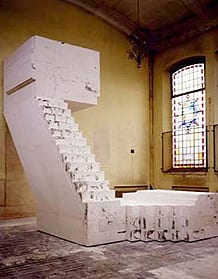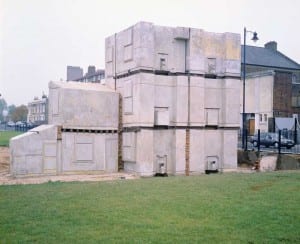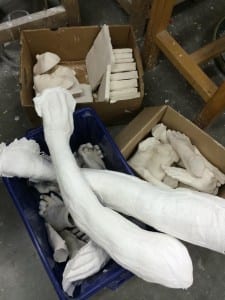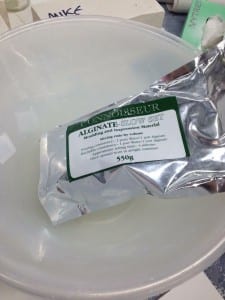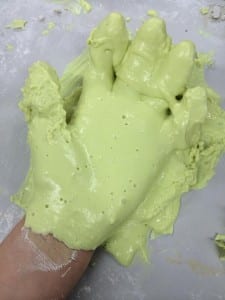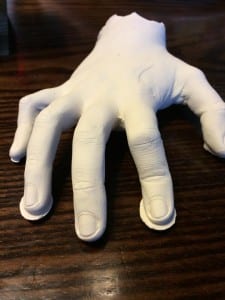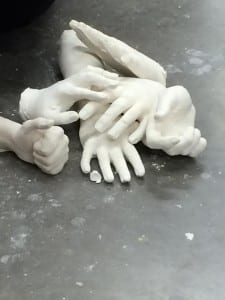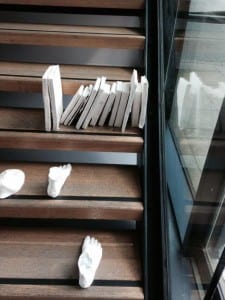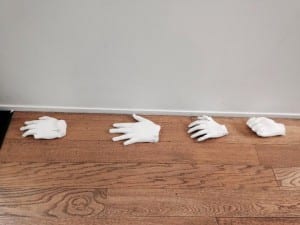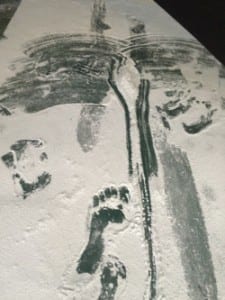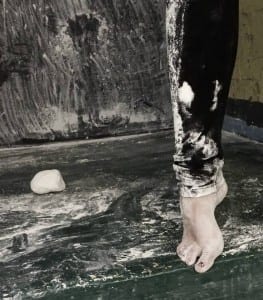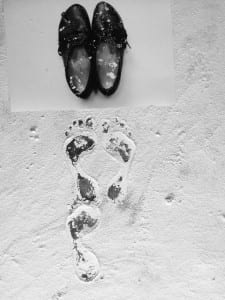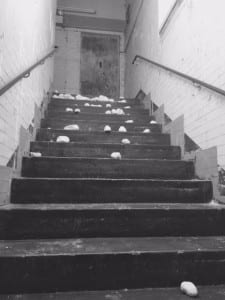Set In Stone
Our initial stimulus and research began with our site, The University Library, allowing us to explore its history, architecture and function. As a group we chose to set our piece in the back stair way of the library, as we found it was somewhere many people, including ourselves, overlooked. I personally really like the large glass windows as they create a framed effect from the outside. We were also very interested in the different levels as well as the way in which people anatomically use the library, such as the use of the stairs and sitting at a desk. Our performance consisted of two parts; an installation piece for which we made clay casts of body parts and books, and three 20 minute performance that consisted of 3 members of the group exploring the way in which people walked up and down the stairs, and the other 3 members sat one on each level with a part of their body in a modroc cast.
The point of this was to see the relationship between the physicality of the human body and the architecture of the library brought together through the use of the body and book casts. The materials were strategically placed around the performers and many placed on the window ledges to create a framing effect that also mimics the shelves in the library. We performed three times throughout the day, each time changing positions and roles to offer alternative interpretations on the use of space and time to represent the connections between the architecture and the body. The key ideas for our performance were stemmed from three mail elements; instillation and sculptural art, physical movement and sound art. These three components resulted in us getting our main influences from artists such as Kira O’Reilly, Rachel Whiteread and Traci Kelly and Rhiannon Jones.
Analysis of process
Firstly, site was an extremely important aspect of my research and for this, I decided to study further into the Library’s past functions and purposes in order to get a better understanding and knowledge of the building itself. According to Mike Pearson “The play-as-event belongs to the space, and makes the space perform as much as it makes actors perform” (Pearson, 2010, p1) therefore, by understanding and learning about the building the more we can use it to enrich our performance.
To begin the process of understanding what a ‘Site Specific performance’ is, we were given an article on Etchell’s ‘Eight Fragment’s on Theatre and City. After reading through it, I fund two ‘fragments’ which interested me and gave me a further insight into how performance can be produced all over cities.
‘Maintenance’ describes a person’s repetitive “ritual” (Etchell, 1999, 77) in which he/she walks the same way at the same time every day. The person’s strange actions oppose the everyday normalities of life, however the repetitive nature also reflects human’s tendencies to repeat their everyday lifestyle as if it is ritualistic. (Getting up, going to work, going to bed).
This correlates with the repetition that flows through our site, both past and present. When the library used to be a factory, workers would have had set repetitive tasks to undertake throughout the day. Similarly this repetitive act is seen throughout the library; whether it’s through the essay writing process (research, plan, draft, re-write, submit) or through accessing and navigating round the building (sign in, find somewhere to sit, do work, sign out).
‘Destruction/Construction’ concerns itself with “the fascination of ruined places, of incomplete places” (Etchell, 1999, 78). These buildings create an impression of unfinished business and decay. The history of such a place cannot be ignored as with every building, comes a story, a past. For Mike Pearson, places like this allow “the past to surge into the present” (Pearson, 2010, 10). The people who resided in or merely visited these places in the past leaves a residual impression in the place itself.
Although the library isn’t incomplete, visually we can distinguish the old parts of the building with the new. Personally I find it really interesting how the new architecture integrates with the old, how its past is still visually accessible.
-Structure of wooden beams on the third floor
-vast array of old style windows
-large glass windows making up walls
-different shapes, angles and colours of new building
-evidence of reinforcement
Drawing further onto the building and its architecture, we were given the task to find a place of interest within the library and spend time there just being. I recorded my thoughts and responses to my chosen site in a form similar to a stream-of-consciousness. My chosen area was the back wall of the first floor where the black windows are. At first the idea of taking notes on a part of the building didn’t sound too appealing, but I found it fascinated me leaving many unanswered questions and thoughts in my head. My observations are listed below;
-brick wall displaying the building original structure
– Metal black/grey beam
-aged/eroded bricks
-Evidence of reinforcement through nails and bolts to help with stability
-areas of concrete highlighting absence and decaying of bricks
-Areas where the bricks are black- intentionally?
-the pattern of the bricks changes above the window, possibly built at different times/possibly a design feature.
-all bricks look very similar- are they all original? Who placed them there?
-the low window starting from the floor is an appealing feature of the architecture
I found this task highly intriguing as it made me pay close attention to detail I would have otherwise looked past. I feel that it has furthered my focus onto the building and its architecture, allowing me to see the building as a performer itself rather than just containing a performance.
As a group we decided the majority of our interests lied within the architecture of the building, coupled with the human interaction that goes on within it. We felt that as students the Library plays an influential and critical role in our studies and work. It’s a place designed for us, to help enhance our learning. This resulted in us feeling personally connected and involved with the library making us a part of its history. Expanding on this, Rom’s theory that “to walk is to leave footprints” (Pearson, 2010, 21) suggests that each person adds to the history of a place or space and that these footprints resemble the mark and memory of that person. Every time we enter a space or a place, “the visitor is aware that each surviving doorway was once entered, each window was once looked through” (Pearson, 2010, 24). Their residual presence survives in these spaces and it is vital to recognise the importance of this in order to fully understand the history of a place itself. –does this then make us influential to the building? Will our presence remain or make an impact?
We toyed around with the idea of us adding to the history of the building exploring the connection we have with it. Which lead to our starting idea of being embodied into the architecture, becoming a part of the building itself. Through the possible use of body casts, we want to explore further into creating links between the body and the building, possibly trying to integrate ourselves into the architecture. Hopefully, this will display more of a literal visual influence and involvement that will contrast the subtle unrecognised influence we have on the building that until now, I know I have overlooked.
Exploring movement on site
Marvin Carlson theorises that “places of public performance […] are marked by the traces of their other purposes and haunted by the ghosts of those who have used them in the past” (Govan, 2007, 139). In my spare time I re-visited our chosen site and focused solely on the stairwell. I wanted to look into the way in which people physically use the stairs. I documented the physicality of the movements required to move up and down the stairs also interactions between people when they passed each other. The variation was astounding. Not only did I see a difference in the way people physically placed their foot on the step; ranging from the heel first, to the ball of the foot and toes first to side stepping down the stairs, but also a huge deviation in pace and rhythm. This experiment made me question the way I walk up and down the stairs and the pace in which I do it. It began to turn into a sequence, a type of pattern with the different overlaying footsteps that didn’t visually match the person’s feet I was watching. However, the main thing I noticed was the reliance and dependence on the hand rail, in particular when descending. Is this just because it’s there, or do people genuinely rely on it for support and assistance? I experimented walking up and down the stairs both with and without assistance from the hand rail.
Using the rail: I felt relaxed and natural, not really having to focus on the physical movement. My hand slid along the railing offering extra ease and guidance especially when descending. I felt that the railing added an element of safety and support.
Without the railing: when walking up the stairs I felt an added strain on my legs as they were the only thing propelling me up the stairs, however, I still felt relatively natural and able to climb them. Although, when walking down the stairs I felt myself notice a decrease in stability and comfort. It created a sense of vulnerability, and unease, and I occasionally found myself reaching for the railing out of instinct.
After feeding back to my group about my exploration of the stairs, we decided to take our research further and looked into the work of Kira O’Reilly, who explores the physicality of the human body through her work. One of her most influential piece’s for us was her durational performance of ‘Stair falling’ (2010). It’s a slow motioned piece in which she falls down the stairs backwards.
(See fig. 1)
https://vimeo.com/15900495
I found her work very inspirational as it has a direct correlation with our piece. In particular, the way in which each movement was so definite and precise, coupled with her intimacy with the stairs and careful control of her body. “Body and building architecture are compared within a precarious relationship, trying to find moments of balance, which are lost to the ungainly.” (The drawing board, 2013) For me the piece exemplified the trust and reliance she shared with the building as well as the care and control taken in each movement. We were then further able to progress our rehearsal process through developing a closer more and familiar relationship with our site. Ultimately this will help develop our confidence when working with the stairs to create a more comfortable performance.
Exploring the use of materials
Rachel Whiteread was one of our main influences when working with space and materials. She is widely recognised for her popular piece ‘House’ which explores the use of materials and preservation to create a theatrical meaning. In an interview, If walls could talk, Craig Houser question Whiteread on her most recent body of work including the ideas behind ‘House’. “I was thinking for this piece that I wanted to try and flip the architecture a little bit. I wanted to change the way one might think about how you walk around or through something” (Whiteread, 2001, 51) as our focus is centred around architecture and the body, Whitereads work directly links with what we are trying to achieve.
(See fig. 2)
Further exploration into her work displayed a transformation in site and meaning. Her manipulation and subversion of materials and objects, is something I feel inspired us all, we wanted to create a new experience for our audience giving them a new perspective on what we show/perform “to redirect our gaze to that which was an absent, a void, the uncanny spaces beneath the surface of everyday life.” (Whiteread, 2001, 33) Sigmund Freud’s theory of the ‘Uncanny’ is something I personally am very interested in and looked further into. The uncanny represents ‘that class of the frightening which leads back to what is known of old and long familiar’ (Freud, 1919,1) The Etymology of ‘uncanny’; is the English translation of the German words ‘heimlich’ (homely) and ‘unheimlich’ (‘unhomely’). Heimlich can mean familiar, intimate and cherished, but can also mean weird, concealed and secret. This linguistic ambiguity underlies the ‘special core of feeling’ that characterises the uncanny. Through our exploration of body and architecture I want to create a sense on the ‘Uncanny’, using everyday familiar objects and spaces subverting them giving a new meaning and purpose. “what is “uncanny” is frightening precisely because it is not known and familiar.” (Freud, 1919, 2)
As drama student we know the limitations to working with the human body are endless. We experimented with the use of modroc casting parts of the body to stimulate a similar effect achieved by Rachel Whiteread. The effect replicated the arm we had cast, however, didn’t pay close attention to detail.
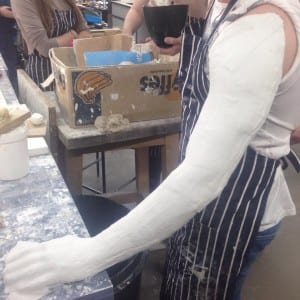
With help from the art department we were shown how to create a more realistic, life-like version of what we made above. To do so we used a variety of materials such as, alginate, modroc and plaster. The results were amazing. We couldn’t believe detail the alginate had picked up, every vein, every line, every bit of detail was evident.
We worked very close with the technician Robert Britt who gave us an induction on how to work with the materials and in the workshop. As a group we dedicated a lot of time to creating our sculptures which resulted in us making 60 books, 40 hands, 30 feet and three faces.
We explored the possibilities of use for our body casts by placing them on site and documenting people’s reaction to it, some people stopped to have a look curious to what it was, where as many people ignored it and walked straight past. The mixed responses we got displayed a sense of curiosity coupled with the reflection of the ‘uncanny’ a familiar object presented in an unfamiliar way. Our interest in sculptures stemmed our research further to discovering the work of artists such as Antony Gormley who is a British artist who works closely with architecture, the human body and sculptures. In an interview he stated “The sculptures will be like standing stones: Markers in space and time, linking with specific places and their histories.” (BBC, 2015) Antony Gormley has a direct link with ‘site specific’ and links all his work “with specific places and their histories” something we are trying to achieve through our piece.
Working on site
Originally we wanted to place items on the stairs for example, books stacked up as if on a shelf and feet placed to mimic a walking effect, that also cause passers-by to feel restricted as to where they can walk, visually displaying the footsteps that had been there before theirs. However, when consulting with the library staff they raised concerns about health and safety as our chosen site is the library’s designated fire exit route. Luckily we were only experimenting so this didn’t come as a setback, instead we laced the books on the window ledges still creating a shelved effect. We placed the hands and feel along the back wall of each level which represented a blend of the past workers and history with us the current users of the library.
Traci Kelly and Rhiannon Jones work on Michael Pinchbeck’s The Drawing Board came as an inspiration to us much later on in our work. The main thing we took from their work was the way in which they threw their creations down the stairs allowing them to crumble and break. This disintegration effect highlighted the vulnerability of our work, also reflecting the way in which the building has crumbled and worn away overtime. Further suggesting that noting last forever, the change of physical shape of our sculptures when dropped down the stairs symbolises the change undergone by the building, its structure has been manipulated to suit its purpose.
Video accessible from link below (See fig. 3)
http://drawingboardproject.tumblr.com/page/2
Furthermore, another aspect of The Drawing Board that also inspired us was the use of chalk. We incorporated this into our work by putting chalk and white face paint on the palms of our hands and feet. This allowed us to leave a visual trace of our presence in the building.
Another influence in our work was through the use of audio. We created a soundscape of people footsteps walking up and down the stairs. When exploring the site we noticed it’s diversity concerning its acoustic opportunities. Covering three floors, we noticed that we could hear people in close proxemics but couldn’t uncover where the sound was coming from. With this in mind we played the soundscape’s for the duration of all three of our performances. I feel this gave the piece an added depth and combined the real with the artificial, causing our audience to have difficulty distinguishing between sound of the footsteps and our movements.
Evaluation
Our performance took place on Saturday 9th May, the installation was available to view from 2pm-7pm with three live performances at 4:30, 5:30 and 6:30. Our desired connection between the building and the people within it was evident in our final performance. As a group we hadn’t ever devised a performative piece quite like it, but the end result was incredible interesting to not only be a part of but also to witness. The layers of sound, art and performance all came together to produce a fascinating exploration of the body and its relationship with the building.
One part of our performance that I thought created a particularly eye-catching image was through the way in which we place the plaster hands and feel along the back wall on each level. This represented a blend of the past workers and inhabitants with us and our hands and feet still in the basic modroc casts. I feel that this symbolises our involvement in the building and its history as it is still being formed and shaped. Our incomplete casts contrast the ones that have been completed and have already left their mark. Furthermore, this stillness is contrasted through the soundscape of multiple footsteps and the three performers constantly moving up and down the stairs.
Although our audience was predominantly made up of the people wishing to use the stairs, the framing effect created by the glass windows allowed us to expand our spectators with people viewing the performance from all angles and distances. It was interesting to see people’s responses to what we had created, some tried to interact with us, asking what we were doing and why, others merely walked past not knowing what was going on around them- perhaps we made them feel uncomfortable? Or like they were intruding? Whilst it was apparent other people were intrigued by what we were doing and wanted to explore it further making themselves spectators. I really enjoyed how the site was kept open to the public and students as it resulted in an array of reactions that we wouldn’t have achieved if it was a typical performance. In many ways the audience created an added layer to our performance highlighting the buildings purpose and adding to busy fast pace motion of the piece, the audience became part of the performance without realising it.
For me the most interesting thing about performing Set in Stone was the constant flow of ideas throughout the piece. Each performance resulted in a brain storm of new ideas on how to evolve the piece further. This allowed our piece to constantly be changing and developing, with our exploration of books heightened in our last performance. For example, we would move books from one window ledge to another whilst walking up and down the stairs to highlight the ever-changing qualities of the library.
Overall, I feel his module has taught me a lot about performance and connections with heritage and site. I have learnt a lot of new skills and attributes over the course of the module and have deepened my knowledge about art and performance as a whole. Additionally, I feel we achieved our main aim of making connections between architecture and the human body to create an exciting, new, thought evoking site specific performance.
Bibliography
Pearson, M. (2010) Site Specific Performance. Basingstoke: Palgrave Macmillan
Etchell, T. (1999) Certain Fragments. Eight Fragments on Theatre and City. London: Routledge.
Govan, (2007). Between Routes and Roots. Performance, Place and Diaspora. 136-143.
Rachel Whiteread: transient spaces. (2001) New York, Guggenheim Museum publications.
BBC (2015), Sir Antony Gormley sculptures placed at five UK beauty spots. [online] London:BBC Available from http://www.bbc.co.uk/news/entertainment-arts-32702277 [Accessed 10th May 2015]
Whiteread, R. (2013) House [image] available from::http://www.apollo-magazine.com/house/ [Accessed 2nd March 2015]
Kelly, T. and Jones, R. (2014) The Drawing Board #6 [image] Available from: http://drawingboardproject.tumblr.com/post/104331954125/the-drawing-board-6-traci-kelly-and-rhiannon# [Accessed 15 April 2015].
